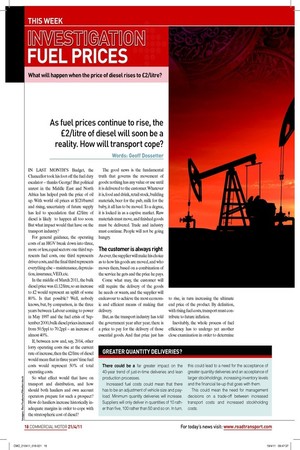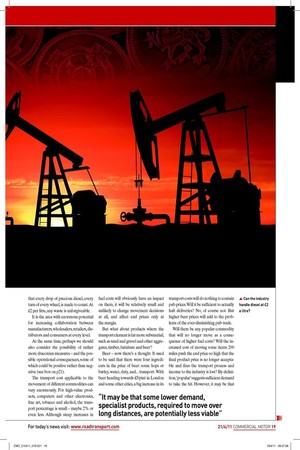As fuel prices continue to rise, the £2/litre of diesel will soon be a reality. How will transport cope?
Page 13

Page 14

Page 15

If you've noticed an error in this article please click here to report it so we can fix it.
Words: Geoff Dossetter
IN LAST MONTH’S Budget, the Chancellor took his foot off the fuel duty escalator – thanks George! But political unrest in the Middle East and North Africa has helped push the price of oil up. With world oil prices at $120/barrel and rising, uncertainty of future supply has led to speculation that £2/litre of diesel is likely to happen all too soon. But what impact would that have on the transport industry?
For general guidance, the operating costs of an HGV break down into three, more or less, equal sectors: one third represents fuel costs, one third represents driver costs, and the inal third represents everything else – maintenance, depreciation, insurance, VED, etc.
In the middle of March 2011, the bulk diesel price was £1.12/litre, so an increase to £2 would represent an uplift of some 80%. Is that possible? Well, nobody knows, but, by comparison, in the three years between Labour coming to power in May 1997 and the fuel crisis of September 2000, bulk diesel prices increased from 50.5ppl to 70.2ppl – an increase of almost 40%.
If, between now and, say, 2014, other lorry operating costs rise at the current rate of increase, then the £2/litre of diesel would mean that in three years’ time fuel costs would represent 50% of total operating costs.
So what effect would that have on transport and distribution, and how should both hauliers and own account operators prepare for such a prospect? How do hauliers increase historically inadequate margins in order to cope with the stratospheric cost of diesel? The good news is the fundamental truth that governs the movement of goods: nothing has any value or use until it is delivered to the customer. Whatever it is, food and drink, retail stock, building materials, beer for the pub, milk for the baby, it all has to be moved. To a degree, it is locked in as a captive market. Raw materials must move, and inished goods must be delivered. Trade and industry must continue. People will not be going hungry.
The customer is always right
As ever, the supplier will make his choice as to how his goods are moved, and who moves them, based on a combination of the service he gets and the price he pays.
Come what may, the customer will still require the delivery of the goods he needs or wants, and the supplier will endeavour to achieve the most economic and eficient means of making that delivery.
But, as the transport industry has told the government year after year, there is a price to pay for the delivery of those essential goods. And that price just has to rise, in turn increasing the ultimate end price of the product. By deinition, with rising fuel costs, transport must contribute to future inlation.
Inevitably, the whole process of fuel eficiency has to undergo yet another close examination in order to determine that every drop of precious diesel, every turn of every wheel, is made to count. At £2 per litre, any waste is unforgiveable.
It is the area with enormous potential for increasing collaboration between manufacturers, wholesalers, retailers, distributors and consumers at every level.
At the same time, perhaps we should also consider the possibility of rather more draconian measures – and the possible operational consequences, some of which could be positive rather than negative (see box on p21).
The transport cost applicable to the movement of different commodities can vary enormously. For high-value products, computers and other electronics, ine art, tobacco and alcohol, the transport percentage is small – maybe 2% or even less. Although steep increases in fuel costs will obviously have an impact on them, it will be relatively small and unlikely to change movement decisions at all, and affect end prices only at the margin.
But what about products where the transport element is far more substantial, such as sand and gravel and other aggregates, timber, furniture and beer?
Beer – now there’s a thought. It used to be said that there were four ingredients in the price of beer: some hops or barley, water, duty, and... transport. With beer heading towards £5/pint in London and some other cities, a big increase in its transport costs will do nothing to contain pub prices. Will it be suficient to actually halt deliveries? No, of course not. But higher beer prices will add to the problems of the ever-diminishing pub trade.
Will there be any popular commodity that will no longer move as a consequence of higher fuel costs? Will the increased cost of moving some items 200 miles push the end price so high that the inal product price is no longer acceptable and thus the transport process and income to the industry is lost? By deinition, ‘popular’ suggests suficient demand to take the hit. However, it may be that some lower demand, specialist products, required to move over long distances, are potentially less viable.
What about expensive, transport-intensive, luxury or niche products like organic vegetables, organic milk, or even cut lowers? Here there are transport costs at every stage of production for what can already be regarded as expensive, and may be considered by some as unnecessary items, and for which cheaper products will continue to be available. Transport is involved at the farm or plantation, at the processing plant, at the bulk distribution, and at retail delivery. It could be that a dramatic increase in diesel costs would make such products and similar specialist items vulnerable to a price hike that would turn already expensive products into unviable options. But even here that must be doubtful: production costs, market forces and pricing policies have the habit of inding appropriate levels of demand and supply suficient for continuity.
More likely, rather than products actually becoming unavailable, production and transport networks will be required to adapt to minimise distribution costs.
Geoff Dunning, chief executive of the Road Haulage Association, suggests that local sourcing may become more important. “It is highly likely that both industry and retail sectors will change their operations to minimise transport, leading to new ways of managing supply chains. If the fuel price is likely to remain high, central RDCs may become unviable, with food miles in particular dropping dramatically. Will imported food become a rarity, and the vast range of choice that the retailers currently offer disappear?”
Alternative energy?
With the price of diesel climbing, other fuel sources come into play. Does this mean that the day of the electric truck has inally arrived? Does the cost penalty of burning expensive diesel inally outstrip the payload penalty of carrying heavy batteries on trunking movements? Probably not. Current battery and electrical vehicle technology remains a long way off making electric a really viable alternative to diesel for longdistance work.
What about gas-powered vehicles and hybrids? Research and development continues and will undoubtedly result in solutions to speciic operations and applications.
But there is no sign yet of a major breakthrough likely to result in a total revolution. In the meantime, electric remains a prospect for smaller vehicles on local deliveries. ■













































